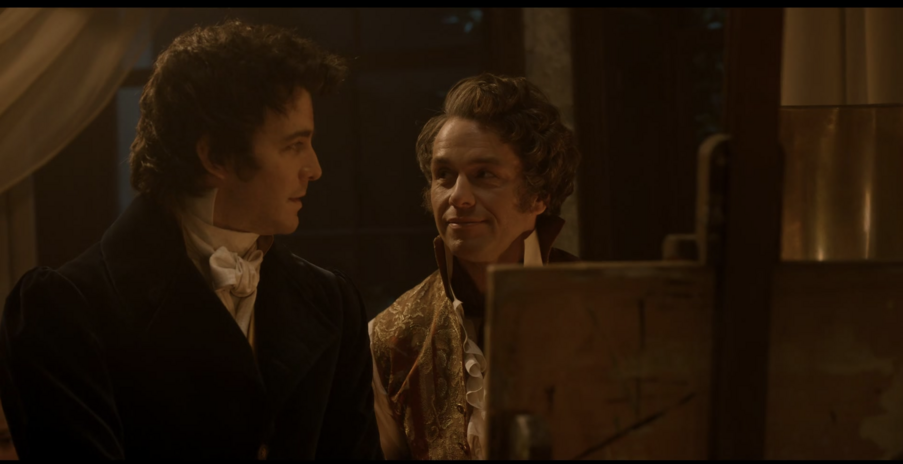Like many of you, I binged Bridgerton all in one sitting. I was enthralled by the beautiful costumes, the witty dialogue, and the diversity within the show. Bridgerton almost lived up entirely to the excitement I felt while watching the trailer. However, one aspect threw me off completely: the trailer made the choice to include a sex scene between two men, but the show barely had any LGBTQIA+ representation. Besides that one scene, there was only one other that mentioned being gay, and even then it was only in passing. Netflix deliberately inserted that clip to signal a gay romance, but in fact, all LGBTQIA+ storylines are relegated to a single five minutes of screentime and a tertiary character.
There’s an entire episode dedicated to Daphne and Simon having sex; you could skip episode six entirely and miss pretty much nothing in the plot. However, none of that was included in the trailer. This gay romance added little to the show, and the trailer teased a storyline that didn’t exist. Its “progressiveness” became performative, if not completely queerbaiting.
So what exactly is queerbaiting?
Queerbaiting is a tactic used by media creators to hint at queer representation – particularly same-sex romances – without ever actually depicting LGBTQIA+ stories within their work. LGBTQIA+ and ally audiences become the “bait,” and consume the media in the hope of storylines that never come to fruition, exploiting those queer viewers and fooling them into believing that their stories will finally be told.
Queerbaiting is used to pander to an LGBTQIA+ audience, and trick them into believing that their narratives will be depicted on screen, but to never actually depict it to not “offend” other audiences. To be quite frank, it’s an opportunity for production companies to make money off LGBTQIA+ people and homophobes at the same time.
More than anything, queerbaiting is marketing — allowing production companies to align themselves with “both sides” without ever formally doing so. Often, queerbaiting plays off of stereotypes and preconceived notions about LGBTQIA+ people, affirming these stereotypes and making viewers believe that a character is gay because they’re representative of a narrow version of what gay people act or look like. Viewers are presented with LGBTQIA+ stereotypes without ever seeing real LGBTQIA+ representation.
Where is the queerbaiting in Bridgerton?
Two words: Henry Granville. Remember him? If you don’t, I can’t blame you. Henry is a minor character, whose role is confined to speaking three sentences to Benedict Bridgerton at parties and then walking away. He’s a queer artist who brings Benedict into the art world. Within that journey, Benedict walks in on him having sex with his male lover. Henry quickly explains that his wife is aware that he’s gay and they have an arrangement. After this, Henry isn’t really mentioned for the rest of the series.
The inclusion of Benedict walking in on Henry in the trailer hinted to fans that this would be a large storyline in the show. While Benedict is accepting of his friend, the pair only converses twice more in the series for short periods of time. Instead of exploring tolerance in a period of heavy intolerance, Bridgerton never addresses the significance of accepting queerness in the Regency era, and the topic is never brought up again.
Benedict was a missed opportunity for representation
Prior to Benedict’s discovery about his fellow artist, the show hinted toward Benedict possibly being a member of the LGBTQIA+ community as well, a break from the show’s romance novel roots. For a character that spent most of his prior screentime sulking or silently remaining behind his brothers, Henry got Benedict to speak boldly, try new things, and question his role in the world. There’s an instant chemistry between the pair, and an intimacy presented through their mutual love of art, their conversation about being second sons, shared smiles at one another at the gallery and in Henry’s study. Benedict attends Henry’s libertine party where the rules of greater society don’t apply, and where he can defy what was seen as moral during that time.
Benedict and his younger sister Eloise discuss their desire to break away from societal expectations. Eloise laments her inability to become educated, and the expectation for her to marry as a woman, and Benedict whines about how hindering society is toward him — despite the fact that he’s not expected to work… or do anything besides go to parties. Eloise reminds him of his privilege as a man during this period through one of the most iconic lines from the show: “If you desire the sun and moon, all you have to do is go out and shoot at the sky. Some of us cannot.”

Benedict’s storyline hints toward him discovering his sexuality, as he has the luxury of being the second son and doesn’t have the same societal expectations thrust on him as his older brother. Instead, Benedict encounters the LGBTQIA+ community, and it doesn’t change anything about him or the way he views others. Ultimately, there was no point for the storyline, because nothing grew or changed from it.
Queerbaiting allows production companies to lure in LGBTQIA+ viewers without having to create queer storylines, or create fully realized queer characters. When there are queer characters, as in the case of Bridgerton, they can be denied real characterization because the act of queerbaiting makes just having a queer character out to be enough. As a result, fully-realized queer characters aren’t created because studio execs think they don’t need to be, further preventing television that is representative of the world around us. Henry’s queer storyline was nothing more than an opportunity to create drama and to hint towards a romance that never happened, rather than an opportunity to explore the queer world in the Regency era — which flourished underground. The plot point was truly nothing more than queerbaiting under the guise of representation.


